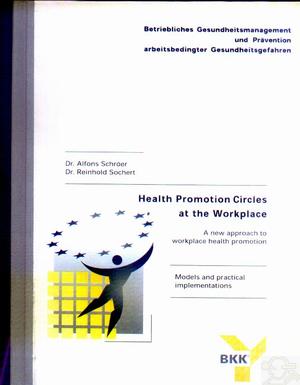Health Promotion Circles at the Workplace
İÇİNDEKİLERContents0 Foreword 1 Introduction: Involving the workforce 2 Activities for small groups and problem solving groups within companies 2.1 Quality circles 2.2 Workshop circles 2.3 Safety circles 2.4 Learning workshops 2.5 Health promotion circles 2.5.1 The Dusseldorf Model 2.5.2 The Berlin Model 3 The development of the health promotion circle concept - the basic model 3.1 Who should attend the health promotion circle? 3.2 Time limits for the project 3.3 Mediation 3.4 Issues to be addressed 4 Health promotion circles in practice 4.1 Prerequisites for the implementation of health promotion circles 4.1.1 Consensus - company agreement 4.1.2 Project steering group 4.1.3 Occupational health and safety committees and health promotion circles 4.1.4 Where to implement health promotion circles 4.1.4.1 The company health report 4.1.4.2 Personnel department data 4.1.4.3 Company safety policy data 4.1.4.4 Employee surveys 4.1.5 Methods of implementation 4.1.5.1 Financial framework 4.1.5.2 Organisational framework 4.1.5.3 Time framework 4.1.5.4 Acceptance framework 4.2 The implementation of health promotion circles 4.2.1 Implementation stagphases - an overview 4.2.2 Preparation 4.2.2.1 Dissemination of information and the selection of participants 4.2.2.2 The employee survey 4.2.2.3 Familiarisation with the workplace 4.2.2.4 Discussion with company experts 4.2.3 Implementation 4.2.3.1 The first circle meeting 4.2.3.2 Second to penultimate meeting 4.2.3.3 The final circle meeting 4.2.3.4 Public relations 4.2.4 Presentation of the results 4.2.5 Putting results into practice 4.3 Evaluation of the circle work 4.3.1 Definition 4.3.2 Evaluation by circle members 4.3.3 Evaluation of circle work by employees 4.3.4 Evaluation of company documents Summary: Value of Health promotion circles in Workplace Health Promotion Appendix: Sample - Project agreements for the implementation of health promotion circles Bibliography    |



